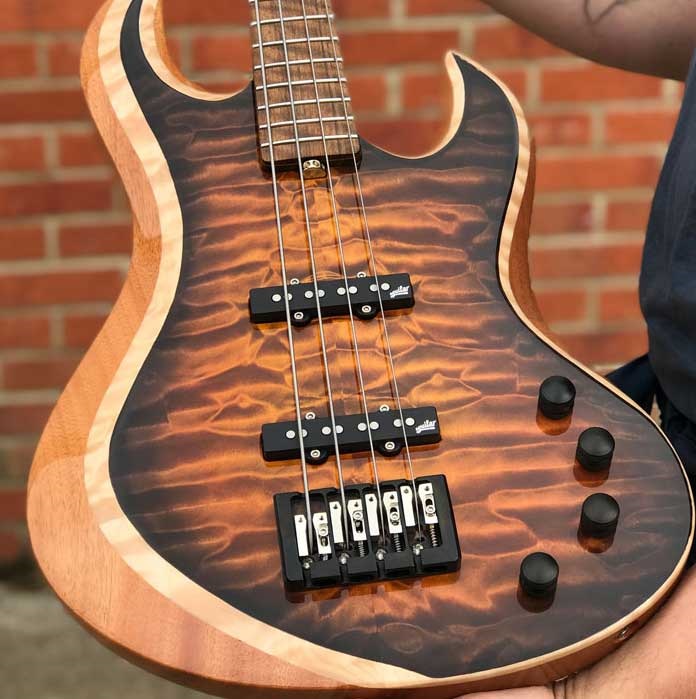What is a passive tone control?
A Passive Tone control is a low pass filter comprised of a three-way variable resistor (potentiometer), and a capacitor.
How does a passive tone control work?
The passive tone control on your electric bass guitar is a subtractive device. The capacitor allows high frequencies to pass or be bled to ground, and the pot allows you to control the amount of signal delivered to the capacitor. A tone control can only reduce frequencies being let through and not add anything extra. In fact, where the tone control is commonly placed is commonly the cause of lackluster results.
Can my bass have better use of the tone control?
Yes. The way in which many electric bass guitars have the passive tone control implemented is less than ideal for what this little circuit can accomplish. Using a Fender Jazz Bass as an example, the main issue is the placement of the tone control in the signal chain. A common Jazz Bass issue, as many owners are full aware, is that unless the neck pickup, bridge pickup, or both are at full volume the tone control “feels weak.” The reason for this is due to where the control is in the signal chain. The illustration below is the standard Jazz Bass wiring common to many if not all Jazz Bass models that utilize three controls.


Is there a better way of doing this?
Absolutely! The tone control can be changed out and replaced with a tandem tone pot, along with rewiring how the pickups are connected to the controls, resulting in much better control of your instrument’s overall tone. The illustration below is an example of how you can rewire your existing controls.


Where can I find this tandem tone pot?
Best Bass Gear currently stocks one version of this particular pot. It is available here:
https://www.bestbassgear.com/east-acg-passive-tone-control-module-only.htm
This is not a stacked potentiometer, but rather a pot that has 6 connections and a single shaft. Using a tandem tone pot not only has benefits of allowing tone control on both neck and bridge pickup independently, but also allows two different capacitors to be used for each pickup. For example, you may want less high frequencies to come through on the neck pickup, but prefer more for the bridge pickup. In that is your goal, you may want to use a 0.047µF for the neck, and a 0.022µF for the bridge.
What capacitor value should I use?
The answer to that question depends on what you are looking for out of your tone control.
Using higher value capacitors shifts the frequency cutoff point, cutting further down into the upper midrange and heads towards the lower midrange.
A lesser value moves the cutoff frequency point higher preserving more of the high midrange when the control is used.
For an instrument with passive pickups, a good starting point is in the range of 0.022µF to 0.047µF. With active pickups such as EMGs, 0.1µF would work. From there, you can experiment with many different values to get a feel for what is possible and pleasing to your ears.
What types of capacitors should I use?
Electrolytic or tantalum capacitors are not recommended.
Recommended capacitor types are Paper in Oil, Ceramic Disk, Mylar, or Poly-Film. There is no significant advantage or disadvantage to using one over another, as performance will be generally equal no matter which type you choose. The value of the capacitor (as in its capacitance and not price) is more important than what the capacitor is constructed from.



Is it possible to do this without the need for a tandem pot?
No. It is best to use a tandem pot for this. We will have more information on doing this very shortly.
No. It is best to use a tandem pot for this.
Potentiometers must be used, otherwise volume cannot be increased or reduced; so as the tone cannot be higher or darker.
By independent tone control you mean the different caps can produce slightly different tones for each pickup; the shaft is still controlling both outputs at the same time to the same degree?
If I never use the tone control: should I leave it out and remove it?
“This is not a stacked potentiometer, but rather a pot that has 6 connections and a single shaft. ”
In what way are these different? Sounds like the same thing to me? – 2 pots rotating the same on one shaft? Are you not getting confused with a log versus lin taper or maybe a concentric pot?
The 6 connections pot in which 3 connect to neck pickup and other 3 connect to bridge pickup. Therefore when you switch between these 2 pickups you can re-adjust the tones (different pickups might have different tones).
If only one pickup, one 3 connections pot is used.
What if I want on/off switches for each pickup, and one volume knob?
The proper name is dual potentiometer, and they’re readily available from Alpha and other manufacturers, along-side the regular pots that we use in guitar and bass builds, without paying $19 and suffering a ridiculous knurled shaft.
https://www.amplifiedparts.com/products/potentiometer-alpha-audio-dual
Dual pots are very common.